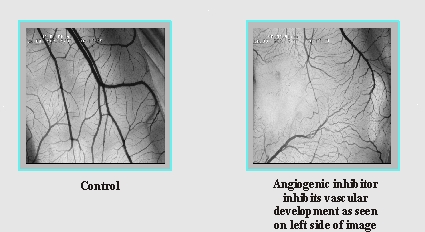

Page 4
Angiogenesis
The process of new blood vessel formation
Chick Chorioallantoic Membrane
This in vivo assay models the angiogenic process in the developing chick using the
accessible chorioallantoic membrane (CAM) with its developing network of blood vessels.
When the CAM appears on day 7 after fertilization, angiogenic inhibitors can be implanted
to prevent vessel growth into the region containing the inhibitor. A sample image showing
inhibition can be seen below.

Development of Therapeutics
GlycoTech's expertise in carbohydrates provides an excellent technical basis to
investigate the glycobiology of angiogenesis. Recent reports have suggested that
lectin-carbohydrate interactions, specifically E-selectin with sLex or sLea, may have a
role. Antagonists of these interactions may be able to control the angiogenic process.
Conversely, enhancement or initiation of angiogenesis may be accomplished by
administrating lectins or their carbohydrate ligands to the site requiring
neovascularization. The initial focus of our research is the identification of these
lectins and carbohydrate ligands that mediate events of angiogenesis.
When these mediators are identified, they would be candidates for development into drugs
for the clinic. The carbohydrates could be used in rational drug design to develop small
molecular weight mimics that would have higher activity than the native structures and
exhibit minimal side effects in the patient. Targeting may be used to increase the
specificity of enhancing or inhibiting angiogenesis. This would also allow efficacy to be
achieved at lower dosage levels.
